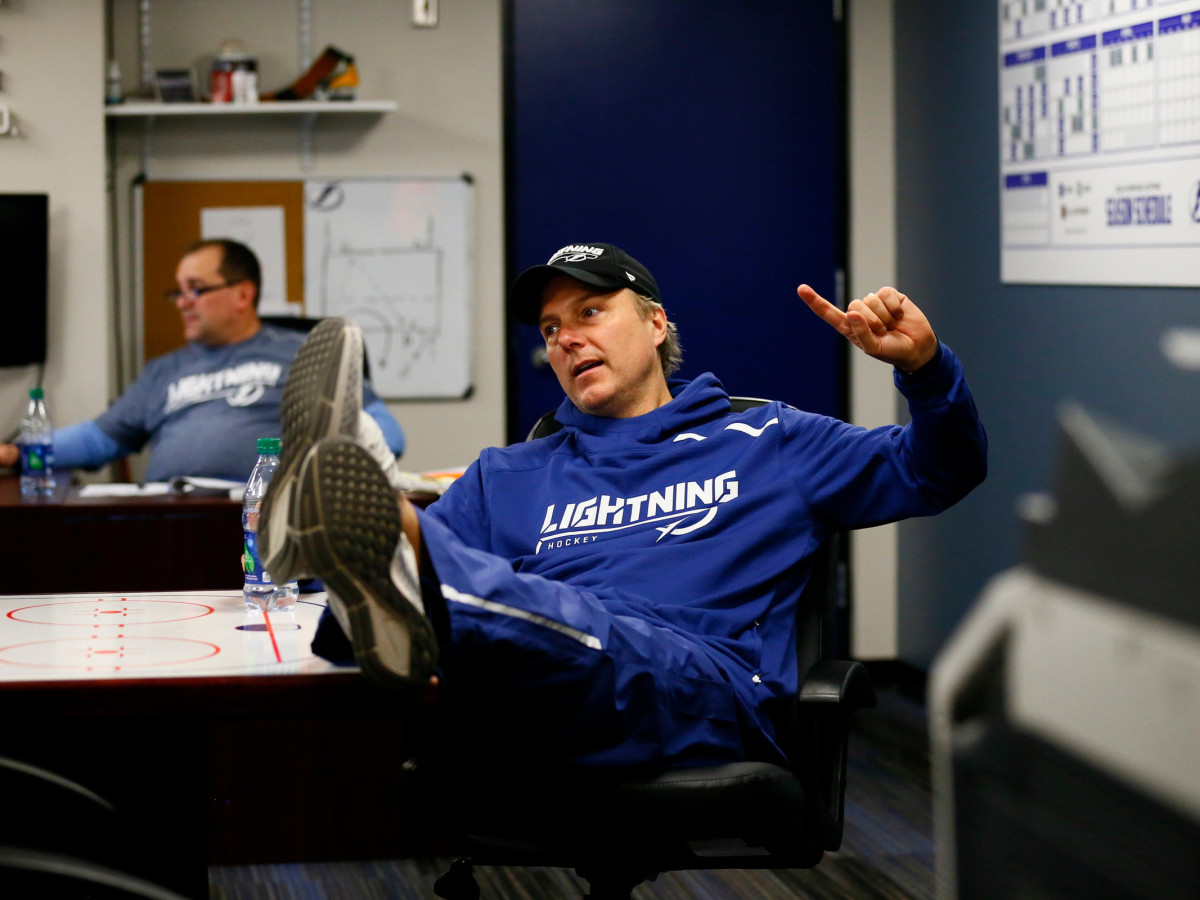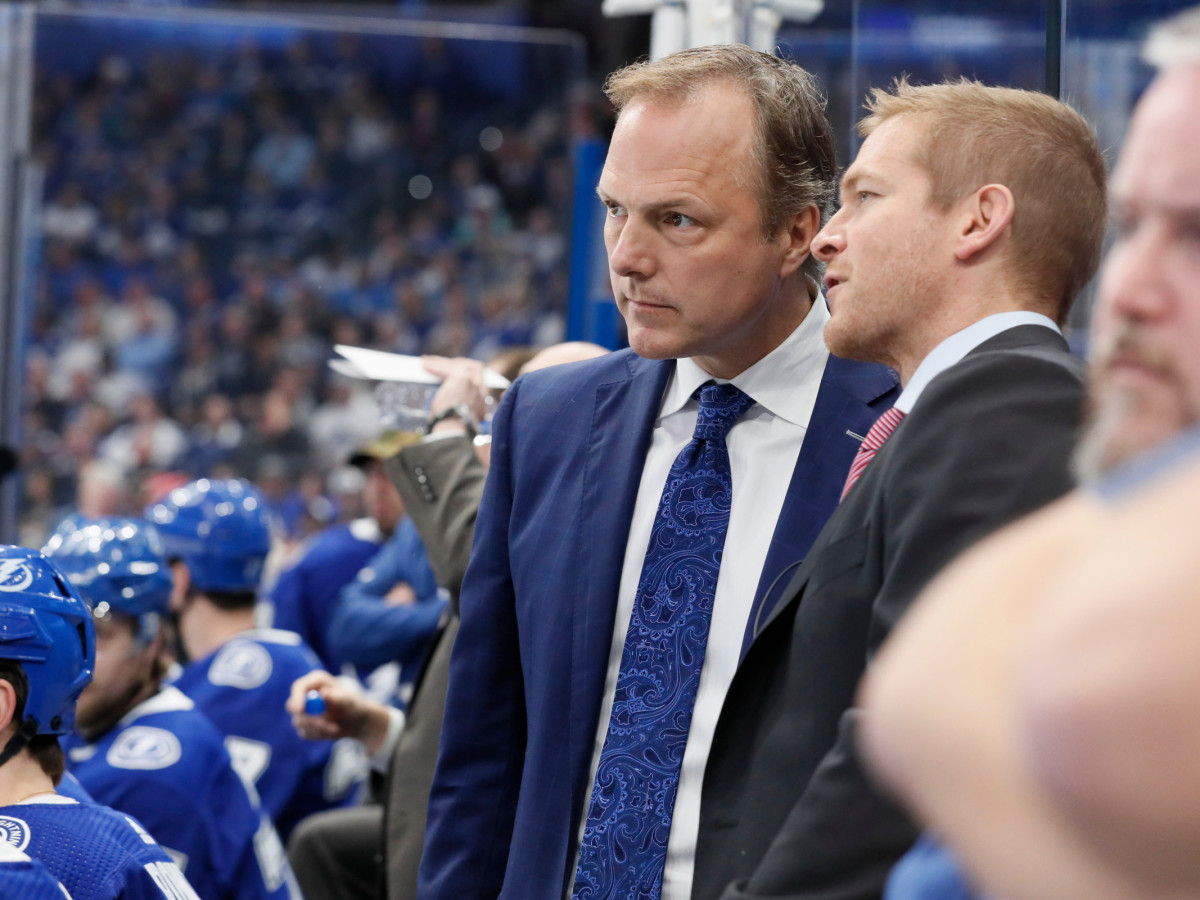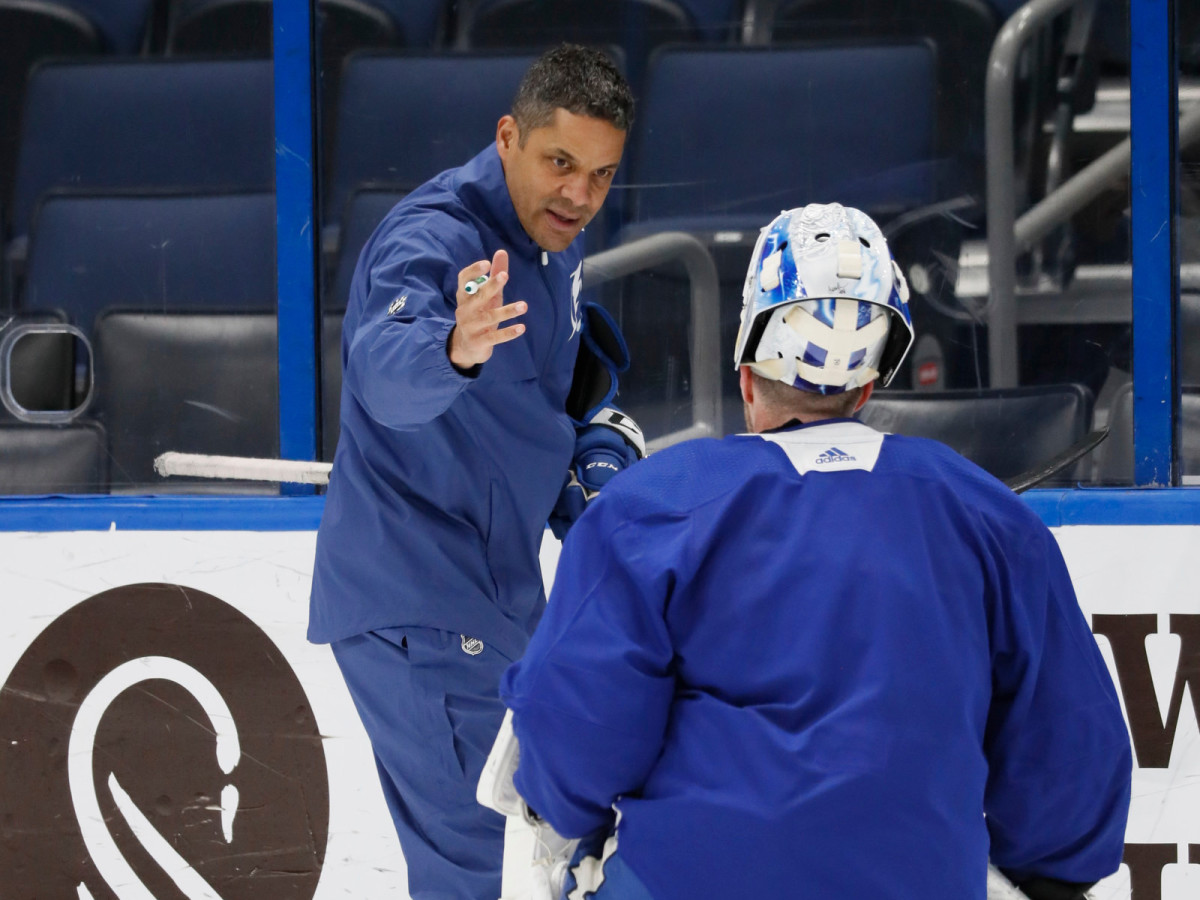Nuts and Bolts: How Jon Cooper and His Coaching Staff Give the League's Best Team Its Edge

This story appears in the Feb. 11, 2019, issue of Sports Illustrated. For more great storytelling and in-depth analysis, subscribe to the magazine—and get up to 94% off the cover price. Click here for more.
It is half past midnight when Jon Cooper emerges from his office at Amalie Arena, necktie loosened under a dark-blue suit, sipping red wine out of a plastic cup stamped with the Lightning logo. He spies a nearby clock. "Ah, f---," Tampa Bay's 51-year-old coach says, an expletive that sounds more like a sigh.
Idling in the doorway, Cooper surveys the standard postgame coaching flotsam: crumpled stat sheets, closed laptops, darkened TV screens, a sushi party platter whittled down to some tuna sashimi and a golf-ball-sized glob of wasabi. By now, though—nearly three hours after the Lightning finished a 6–3 win over visiting San Jose on Jan. 19, maintaining their huge lead over the rest of the Eastern Conference entering the NHL All-Star break—the rest of his staff have gone home.
"I know we're blessed, making a lot of money and all," Cooper says, out of nowhere. "But if you broke it down by hour…."
He grabs a seat in the bullpen, the nickname for the windowless workspace that Tampa Bay's coaching staff shares for studying film, discussing tactics and mercilessly roasting one another. For the past three days SI has hunkered down here with Cooper and his assistants, attending prescout meetings and strategy sessions, seeing how the league's best team—and, at six seasons, its longest-tenured head coach—endeavors to bring order to a chaotic game.
More than their peers in other sports, NHL coaches are rendered largely helpless when the action starts. Sure, they bark line changes and scribble face-off plays on whiteboards, but they aren't MLB managers ordering defensive shifts or NFL offensive coordinators radioing calls from the booth, able to watch their calculations pay off with real-time results. So what is a coach, that singular breed of master micromanager, supposed to do?
Wine is a good start. Legs kicked onto a table, Cooper continues musing.
"I don't think people appreciate all the work that goes into this job," he says. "Because it's a lot more than f------ drawing the X's and O's of a neutral zone forecheck."

DAY ONE JAN. 17
Outside the bullpen door, a small sign glows in blue neon letters: MEETING IN PROGRESS.
"O.K., boys," Cooper says, setting down his coffee at 9:21 a.m. "Let's get our s--- organized."
Bent over their laptops, the boys—assistants Todd Richards, Jeff Halpern and Derek Lalonde, video coach Nigel Kirwan, video coordinator Brian Garlock and goalie coach Frantz Jean—are preparing for tonight's matchup with Atlantic Division–rival Toronto. Over the next nine hours they will plod through the usual game-day routine: morning skate, film-study sessions, team meetings (two), a meeting with each power-play unit, a meeting with the penalty kill…not to mention several discussions about scheduling more meetings.
Don't get the wrong idea, though. This isn't one of those 24/7 operations, all-nighters pulled on air mattresses beneath a projection screen's glow. Tacked onto a cork board behind Richards's desk is the schedule for La Liga—not the Spanish fútbol association but the coaches' monthly nine-hole golf tournament. They play tennis on road trips, race laps in hotel pools and recently held a board game night at which Richards taught everyone the rules to Settlers of Catan. "We also have a chess ladder," Lalonde notes from his desk. "The Princeton guy is not at the top."
The Ivy Leaguer getting razzed would be Halpern, a class of 1999 economics major who played for seven NHL teams over the next 15-plus years and still looks fit enough to skate a few shifts. Like Lalonde, though, Halpern is a rookie behind the bench at this level, which makes them easy targets. When Lalonde reported to work in thigh-hugging bike shorts, Cooper greeted him, "Do you own any mirrors in your house?" The Lightning also have an especially intricate practice exercise nicknamed The Halpy F--- Up Drill after the young coach fumbled through explaining it to players.
No doubt the casual atmosphere reflects the Lightning's perch atop league standings, where they have been since Nov. 29. There were other factors that led to parting ways with assistants Brad Lauer and Rick Bowness last May—among them, Cooper's desire to put Richards, a former minor league defenseman, in charge of Tampa's blueliners—but wanting greater looseness and stronger camaraderie inside the bullpen played a big role. "Chemistry and synergy are paramount," Cooper explains. "If you're trying to build a culture with the players, you'd be a little hypocritical if you didn't have the same thing in the staff."
The players have noticed. "The ability to create as little confusion as possible has been the best thing about this coaching staff since I got here," says defenseman Ryan McDonagh, who was acquired from the Rangers at last season's trade deadline. "But I also think they do a good job of giving the message to us every day in a different way, in different voices, so it doesn't feel stale. That's the sign of a coaching staff that trusts one another."
Another sign: Like any tight-knit group, the coaches have developed their own lingua franca. "Heading to rotary" is hitting the bar after work. "Having an executive workout" means time in the sauna. And if you hear a Lightning player yell "nipple" on offense, he's asking teammates to pass the puck into the slot. "It's a word [that] gets your attention," Cooper says. "If you heard it in any conversation, you'd stop."
After the morning skate Cooper and the assistants return to the bullpen to dissect film of the Maple Leafs' ninth-ranked power play. The Lightning won their last meeting, 4–1 on Dec. 13, but goalie Andrei Vasilevskiy was pelted with 16 scoring chances on six man-advantages. Tonight the Lightning will counter by unveiling a 3–1 neutral zone forecheck—stacking three skaters across the defensive blue line on the penalty kill instead of their usual 2–2 setup. Ordinarily this would be a risky gambit, but Tampa can afford tactical experiments; the team's 129-point pace would tie the 1977–78 Canadiens for the second best in NHL history.
Meanwhile, a pair of new golf shoes has shown up in Cooper's office. (Coaches get tons of swag.) They are slightly too big but the perfect size for Lalonde, who runs the league's sixth-best penalty kill with Richards.
"If their PP goes 0-fer tonight," Cooper says, "you can have them."
He turns around, heads into his office and adds with a wink, "Gotta keep them on their toes."

DAY TWO Jan. 18
Thanks to the new-look penalty kill, which prevented several clean zone entries on each of Toronto's two power plays, Lalonde keeps the spikes. But a second-period defensive breakdown leads to winger Mitch Marner's decisive goal in a 4–2 Leafs victory, ending Tampa's home winning streak at nine, one shy of a franchise record.
Cooper spends the next morning at his semiregular breakfast with Lightning owner Jeff Vinik. The staff has plenty to keep it busy. Kirwan puts the final touches on a clip package of the Sharks' systems, having stayed up until 1:30 a.m. assembling footage from their three most recent games. Richards and Garlock discuss strategy for neutral zone face-offs. Between bites of eggs and fruit, Halpern rewatches last night's game from "coach cam," a fixed high-and-wide angle shot that only the staff can access. "I watched my shifts as a player," he says. "But not like this, poring over it."
As an NHLer, Halpern skated under 12 head coaches. He can still name them all in order, from Ron Wilson to Dave Tippett. His favorites were capable of spelling out specific plans in fresh ways. The worst? Halpern can still picture one standing at the whiteboard, laboring through an inscrutable explanation of a controlled breakout. "In that moment," Halpern says, "he lost the entire room because he sounded stupid."
Now that he is on the other side, Halpern worries about delivery as much as message. It's why he keeps a note card with a Bill Walsh quote in a desk drawer: "Your enthusiasm becomes their enthusiasm; your lukewarm presentation becomes their lukewarm presentation." And why he recently read Practice Perfect, a book about optimizing the act of improving. His biggest takeaway: "Creativity through automaticity," Halpern says. "If you do a drill every day, it's like playing the piano. Eventually you get so good that you can start riffing with the notes."
This advice has proven particularly helpful as he manages the Lightning power play. Fueled by NHL leading scorer Nikita Kucherov, triggerman Steven Stamkos and center Brayden Point's 13 man-advantage goals, the unit is currently converting at an NHL-best 29.4%. "I can read every book on coaching, but I don't think I'll ever get to see the game the way a guy like Kucherov does," says Halpern, a career bottom-six grinder. "When it comes time to being creative within our structure, I'm trying to give them a canvas to paint on."
Besides, the hockey world contains fewer Kucherovs than young players who need teaching. At 11:10 a.m., Halpern unplugs his laptop and heads into the locker room to meet with winger Adam Erne. A second-round pick in 2013, the rugged 23-year-old is halfway through his first full NHL season. Sitting at Erne's stall, Halpern spends several minutes on defensive zone coverage. "If this puck comes out of the corner and hits you," Halpern asks, "what's your next play?" Soon center Anthony Cirelli, another rookie and Erne's recent linemate, sidles up and joins the film session.
"It's a confidence builder for the players to know where they stand, rather than just guessing," Erne says after practice. "Especially for young guys like me who don't necessarily have as many interactions with coaches, the more communication, the better."
Cooper follows that same approach with Tampa's captain. Over these three days he will seek out Stamkos for private chats three times, including this afternoon. "Just to monitor stuff, how we're feeling," Cooper says later, likening such check-ins to conversing with a member of his staff. Stamkos received the C in March 2014, a year after Cooper stepped behind the bench. "We're growing up together, and I think you're seeing the fruits of our labors," Cooper says. "I don't want to be surrounded by a bunch of yes men. Stammer has been good for me in that respect of pushing back.
"I always thought one of my biggest strengths was managing people. But I'm way better now than when I came into the league."

DAY THREE Jan. 19
Only two members of Cooper's staff predate his promotion to Tampa. The first is Kirwan, an original Lightning employee who started in marketing and pivoted to video coach in 1996, when the job required little more than two VCRs and a trunk full of VHS tapes.
The second old-timer arrives this morning at 7:29 a.m. and begins punching data from the Toronto game into an Excel file titled STATISTIQUES GARDIENS SAISON 2018–19. Born to a French-Canadian mother and Haitian father, Jean has been nurturing netminders since age 14, when the owner of a Montreal-area goalie school tapped him to help out during a summer camp. As with his cohorts around the league, Jean largely functions independent of the larger staff. "I'm like a golf coach," he explains. "It's very individualized, very niche."
Even so, Jean is critical to the larger operation. On game days he posts a scouting report that breaks down the opposing goalie's tendencies. Tonight, for instance, after Jean notes that San Jose's Martin Jones is especially vulnerable to high-blocker and high-glove shots, the Lightning will score four times in those two areas during a 6–3 win.
Jean's analytical approach benefits Tampa's goalies too, of course. In the spreadsheet he tracks a dozen categories, such as rebound control and passing play efficiency. After the season he compares these figures with leaguewide averages provided by the Lightning's hockey analytics department. When Vasilevskiy arrived as a first-rounder in 2012, for instance, Jean noticed that the Russian struggled with screened and tipped shots, hovering around a .600 save percentage in those situations. Today Vasilevskiy, who finished third last season in Vezina Trophy voting, has steadied near .900. "Hockey is all about the same patterns," Jean says. "And we have an answer to every pattern."
Or so they try. A few hours later, as techno music from the locker room softly thumps through his office walls, Cooper fills the dead time by revisiting old wounds. Cued on a laptop is footage from last year's Game 7 loss to the Capitals in the conference finals. He watches first as defenseman Victor Hedman pumps a slapper off the near post in the second period, which would have tied the game 1–1, then as forward Yanni Gourde whiffs on a loose puck in front of an open net. Washington would go on to score twice over the next 14 minutes and win 4–0.
"That's the s--- that happens," Cooper says, shrugging. Earlier in his career, like many young coaches, he was obsessed with trying to control the chaos. "Every single detail, over and over," Cooper says. "Can't get caught up in the minutiae. I treated every game like it's Game 7. Every game is not Game 7. There are a lot of Game 1s in there."
Minutia matters most in the playoffs, of course. Before each series Lightning players receive a 10-or-so-page booklet from Cooper and the staff, crammed with scouting reports on specific players and diagrams detailing the opponent's structure. The coaches will be hard at work assembling those books again soon, given Tampa's status as odds-on favorites to lift the Stanley Cup this spring. But the footage unspooling on Cooper's laptop highlights an essential truth: No matter how many hours are poured into scheming new penalty-kill alignments or breaking down goalies, s--- simply happens.
"Hockey's just different," Cooper will say later tonight over his plastic cup of Cabernet Sauvignon. "You can't structurally draw up a play for a puck that is chipped off the glass. You are dependent on guys following the system. The game happens so fast that you need a structure in place, and players have to buy into the system. Because if guys go rogue, there are so many moving parts that the whole thing breaks down.
"And that's why you need a really good staff."
